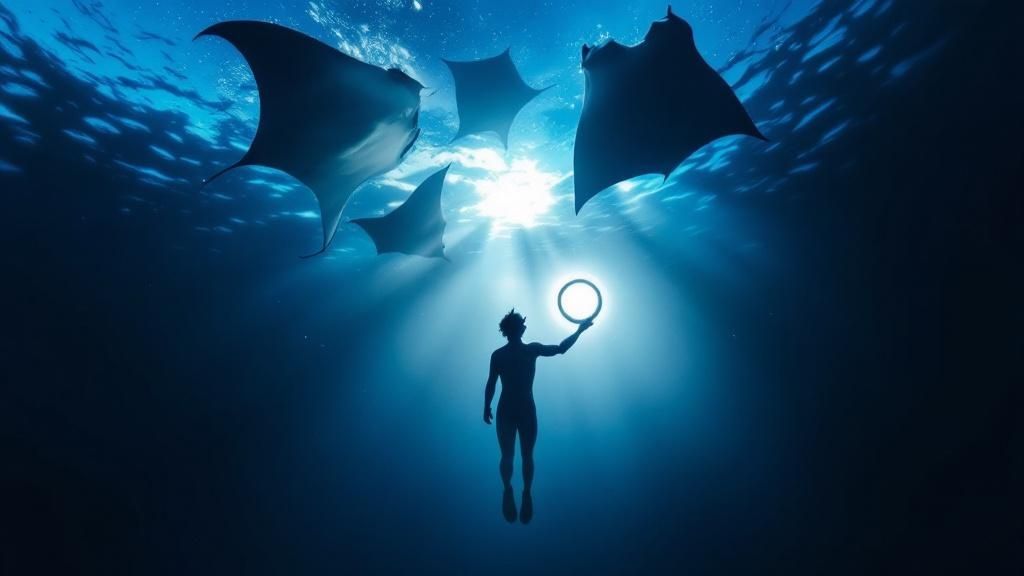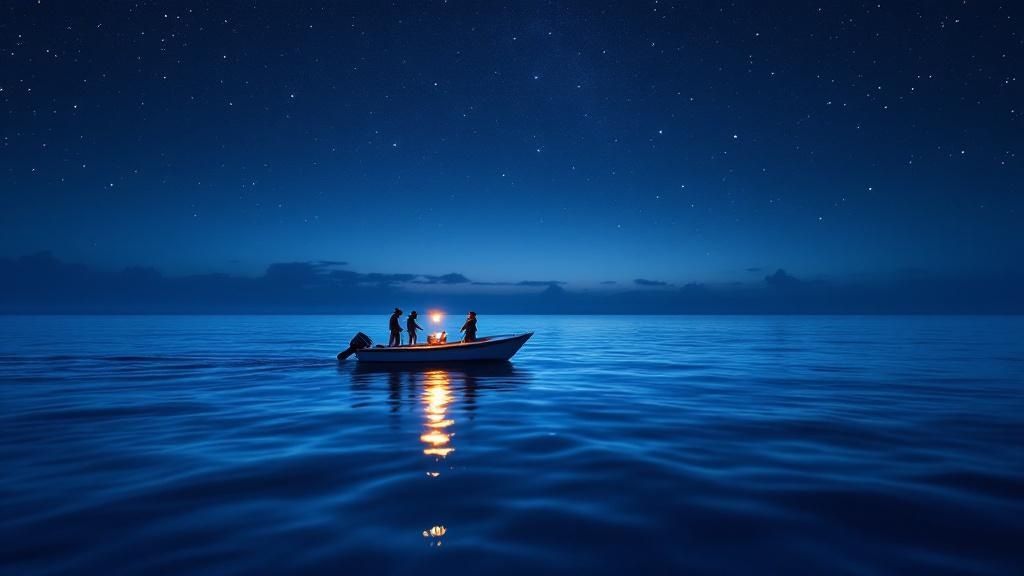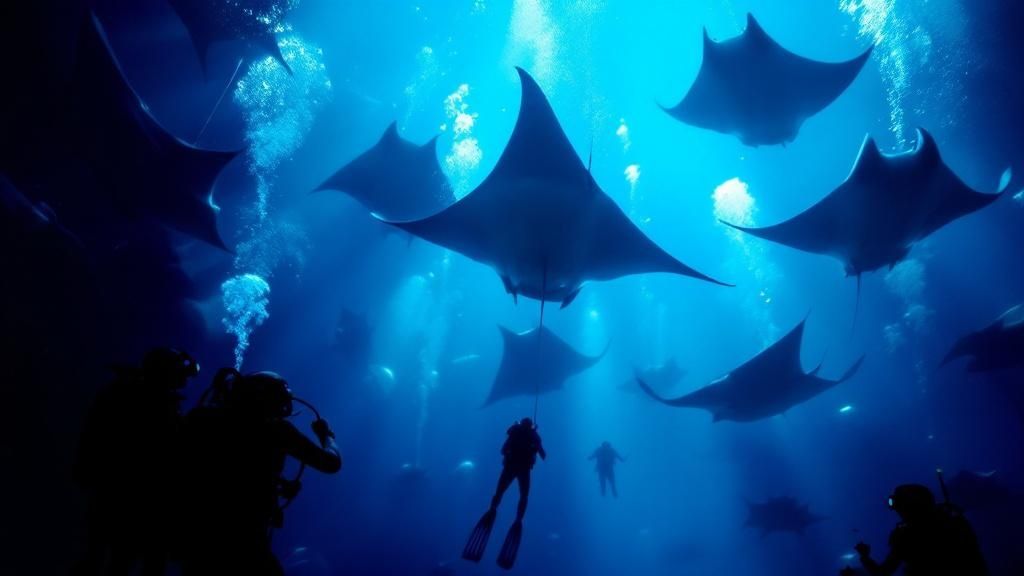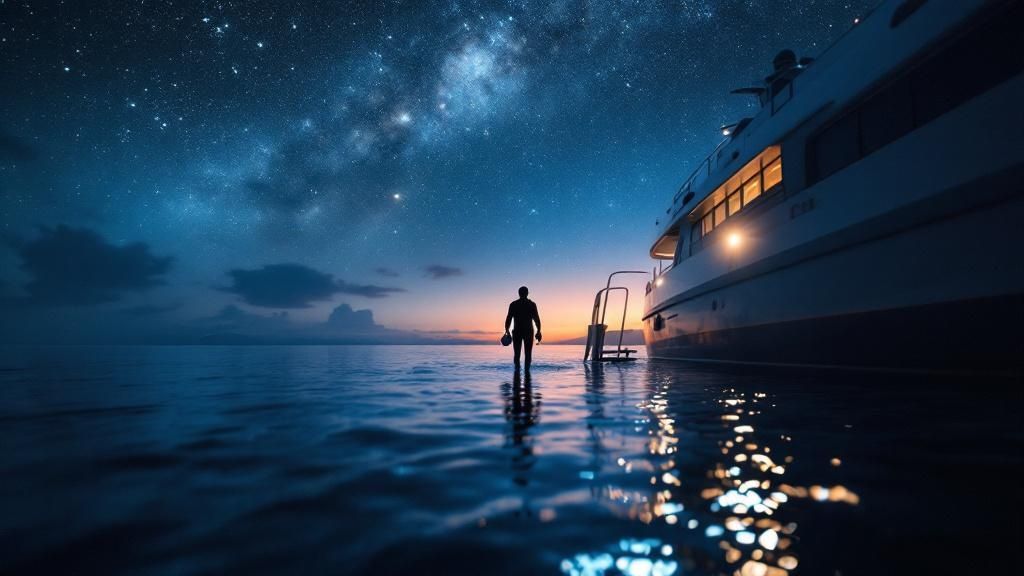Manta Ray Night Snorkel Kona: Unforgettable Kona Experience

The manta ray night snorkel in Kona is hands-down one of the most incredible wildlife encounters on the planet. I've been on countless trips, and it never gets old. You’re floating in the dark, calm Pacific waters while these massive, gentle giants glide and barrel-roll just inches below you, feeding on plankton drawn to the underwater lights. It’s more than just a tour; it’s pure magic and something that consistently tops the bucket lists of visitors to Hawaii. You can book the world-famous manta ray night snorkel tour right here.
Why Kona is the World’s Best Manta Ray Encounter
Picture this: you're floating on the surface of the ocean, with a brilliant canopy of stars overhead. Below, powerful lights cut through the darkness, creating an underwater stage. Then, out of nowhere, a huge, silent shape emerges—a manta ray with a wingspan wider than you are tall. This is the heart of the manta ray night snorkel Kona experience, a moment that will stick with you for a lifetime. If you're looking for the best adventure out there, you can trust us at Kona Snorkel Trips. We're proud to be the top-rated and most-reviewed snorkel company in all of Hawaii.
So, what makes Kona the undisputed global capital for this encounter? It's a perfect storm of geography and biology. The unique volcanic underwater landscape along the Kona coast is a natural sanctuary for these creatures. More importantly, it provides a rich, year-round supply of plankton, their main food source. This reliable "dinner bell" keeps a resident population of manta rays coming back to the same spots, night after night.

Unmatched Sighting Reliability
Unlike a lot of wildlife tours that hinge on seasonal migrations and a good dose of luck, Kona’s manta ray viewing is remarkably consistent. We see an extraordinary sighting success rate, often hitting 85% to over 95%. It's this reliability that brings an estimated 80,000 visitors to Kailua-Kona every year just for this experience, making it a cornerstone of wildlife tourism. The local manta population is estimated to be over 450 individuals, so sightings aren't just possible—they're probable.
This high success rate means you can book your tour with real confidence, knowing you have an excellent shot at witnessing this incredible underwater ballet. Our comprehensive guide covers everything you need to know about the manta ray night snorkel Kona; you can read more about this unforgettable ocean adventure to get fully prepped for your trip.
What to Expect on Your Adventure
To help you get a clearer picture of the night, here’s a quick rundown of what your manta ray snorkel adventure will look like.
Kona Manta Ray Night Snorkel At a Glance
| Aspect | Details |
|---|---|
| Location | Designated Manta Ray viewing sites off the Kona Coast. |
| Duration | Typically 1.5 to 2 hours, including boat ride and in-water time. |
| Activity | Floating on the surface holding onto a custom light board. |
| Gear Provided | Wetsuits, snorkel, mask, and all necessary safety equipment. |
| Best For | Families, couples, solo travelers, and marine life lovers. |
This adventure is designed to be accessible to almost everyone, no matter your snorkeling experience. The whole point is passive observation, letting you just relax and soak in the awe-inspiring scene unfolding right beneath you.
Ready to turn this dream into a reality?
How To Choose The Right Manta Snorkel Tour

Picking the right operator for your manta ray night snorkel kona adventure is probably the biggest decision you'll make for this trip. Honestly, it can be the difference between a decent time and a mind-blowing, "I-can't-believe-that-just-happened" experience. There are quite a few companies out there, so knowing what to look for is key to booking a tour that's safe, comfortable, and respectful of the incredible animals you've come to see.
This isn't just about finding the cheapest price. The quality of your time in the water is directly linked to the crew's professionalism, the boat's condition, and the company's real commitment to sustainable, eco-friendly practices. The best tours put your experience and the mantas' well-being on equal footing. For an adventure that nails all of this, we're proud to recommend the Kona Manta Ray Snorkel Tour our team runs.
Of course, it's always good to have options. If you're looking for another fantastic choice, check out Manta Ray Night Snorkel Hawaii. They are an exceptional alternative known for providing incredible manta encounters.
Key Factors For Selecting A Tour
When you're digging into different companies, a few critical things should be on your radar. Don't be shy about asking direct questions before you hand over your credit card; a good operator will have no problem giving you straight answers.
Here’s what I’d be looking for:
- Crew Experience and Safety: Is the crew certified in CPR and first aid? How much time have the guides actually spent in the water at these sites? Safety is non-negotiable.
- Boat Comfort and Features: What kind of boat are they using? Does it have a proper ladder for getting in and out of the water easily? What about a restroom? A comfortable ride makes the whole experience better.
- Guest-to-Guide Ratio: This is a big one. A smaller group per guide means more personal attention and a much safer, calmer environment in the water. Ask what their maximum capacity is per guide.
- Eco-Friendly Practices: Does the company follow the Manta Ray Green List standards for passive viewing? Choosing a responsible operator is crucial for protecting these gentle giants.
The best tour operators aren't just boat drivers; they're stewards of the ocean. Their mission is to educate you about the mantas and make sure the whole encounter is done with total respect, protecting the rays for years to come.
Why Sighting Location Matters
There's a reason Kona is a world-class spot for seeing mantas, and it's a cool mix of geography and biology. Tour boats anchor at specific sites and use powerful lights in the water. These lights attract plankton, the mantas' favorite food, which brings the rays right to the snorkelers.
The most legendary of these spots is Manta Village. It has a long, proven history of consistent sightings. At one point, tours there boasted an incredible 96% success rate with an average of four mantas spotted per night! You can dive deeper into the history of Kona's manta sites to see what makes these places so special.
Knowing which site a tour frequents can give you a hint about the kind of night you'll have. While Manta Village is famous, other locations like Manta Heaven also offer amazing, high-success-rate encounters.
Making Your Final Decision
At the end of the day, the right tour is the one that feels right for you—one that aligns with what you want in terms of safety, comfort, and responsible tourism. Read recent reviews, see what’s included (like wetsuits and gear), and go with an operator that makes you feel confident and excited.
Your manta ray night snorkel kona tour is a big deal—it's an investment in a memory you'll have for the rest of your life. Taking a little extra time to choose the best guide is the first step in making sure that memory is absolutely magical.
Ready to book a tour that checks all the boxes for an amazing night?
How To Prepare For Your Night Snorkel Adventure

A little bit of prep goes a long, long way. When you feel confident and comfortable, you can really soak in the magic of your manta ray night snorkel Kona experience instead of worrying about being cold or what you might have forgotten.
This guide is all about getting you ready. By the time you step on the boat, you'll feel like a seasoned pro, ready for the incredible adventure waiting for you under the stars.
What To Bring For Your Tour
Packing is pretty straightforward, but a few key items will make a world of difference for your comfort both in and out of the water.
- Swimsuit: The easiest thing to do is just wear it under your clothes when you show up. It makes gearing up on the boat way faster.
- Towel and Dry Clothes: This is a non-negotiable. After your snorkel, you'll be so glad you have a dry towel and a warm layer to throw on. A hoodie or jacket is perfect for the boat ride back, as the night air can feel surprisingly chilly.
- Reef-Safe Sunscreen: I know, sunscreen for a night tour? But most trips head out in the late afternoon. You’ll be on the boat as the sun sets, so protecting your skin and our delicate coral reefs is a smart move.
- Reusable Water Bottle: Staying hydrated is always a good idea. Most tours have water, but bringing your own is a great way to be eco-friendly.
- Underwater Camera (Optional): Got a GoPro? Bring it! Just make sure it’s fully charged and, most importantly, has a wrist strap. You don't want to watch it sink into the abyss.
A quick tip: travel light. Leave the expensive jewelry, tablets, and big bags behind. Storage is usually pretty limited on the boat, so it's best to stick to the essentials.
Addressing Night Snorkel Anxieties
It’s completely normal to feel a bit nervous about hopping into the ocean after dark. For most people, this is a totally new experience. I get it.
But here’s the thing: reputable tour operators put safety above everything else. The boats are well-lit, and you’ll be given a powerful, custom-built light board that illuminates a huge area of water around you. You’re not just swimming around in the pitch black. You'll be holding onto this big, stable raft the whole time, with your guides right there in the water with you. They’re trained pros, constantly keeping an eye on everyone.
Trust in the process and the professionals guiding you. The experience is structured for maximum safety and awe. Your guides have done this hundreds, if not thousands, of times and are experts at making everyone feel comfortable.
Why Using Provided Gear Is A Smart Choice
You might be tempted to pack your own snorkel gear, but I usually recommend using the equipment your tour company provides. Good operators invest in high-quality, professional-grade gear that is meticulously maintained and sanitized.
Their wetsuits are specifically chosen for our local water temperatures, which is key to staying warm enough to enjoy the full 45-minute snorkel. Plus, their masks are treated with anti-fog solution, and their snorkels are designed to be easy to use. Using their gear means one less thing for you to pack and worry about, and it guarantees you’ll have equipment perfectly suited for the manta ray night snorkel Kona adventure.
Ready to book an adventure where every detail is handled?
What The Manta Ray Encounter Is Really Like

The experience really starts before you even touch the water. It begins on the boat, motoring out from the harbor as the lights of Kona get smaller and smaller behind you. There’s a palpable buzz of anticipation on board. As the sun finally dips below the horizon, it puts on a show—painting the sky with fiery oranges and purples before fading to a blanket of stars you can only truly appreciate from out on the ocean.
This short, scenic boat trip is the perfect prelude to the main event. Your guides, who know these waters like the back of their hands, use this time to share some incredible facts about Kona's manta ray population and get you prepped for what you're about to see. Once we drop anchor, a special light board is lowered into the water, casting a brilliant blue-green glow into the dark sea.
For the mantas, this light is basically a dinner bell. It immediately starts to attract clouds of microscopic plankton, their favorite meal. After you slip into the warm water, fully kitted out in your wetsuit and snorkel gear, you’ll grab onto the floating light board. The world above goes quiet. Your entire focus narrows to the illuminated stage below.
The Awe-Inspiring Arrival
At first, all you'll see is the swirling plankton, like a living snowstorm caught in the beams of light. Then, out of the deep blackness, a shadow emerges. It’s a moment that will genuinely take your breath away. The first manta ray glides effortlessly into the light, its massive wings spanning several feet, its movements impossibly smooth and graceful.
Before you know it, another joins, and then another. They begin an incredible underwater ballet, soaring and looping through the water. The experience is surreal; these gentle giants perform acrobatic barrel rolls just inches below you, their cavernous mouths wide open to filter the plankton. All you’ll hear is the sound of your own breathing and the gentle swish of water as they pass. It’s an intimate, humbling, and profoundly peaceful encounter.
The mantas are completely unbothered by you. They are there for one reason: to eat. In doing so, they create a spectacle that feels both wild and perfectly choreographed. This is the heart of the manta ray night snorkel Kona—a front-row seat to one of nature's most magnificent feeding rituals.
The feeling is almost impossible to describe. It's like watching a stealth bomber, a bird, and a ballerina all rolled into one magnificent creature. It's a moment of pure awe that connects you directly to the power and grace of the ocean.
The Most Important Rule: Passive Interaction
During this incredible display, there's one golden rule that ensures both your safety and the long-term well-being of the mantas: passive interaction. This means you are strictly an observer. You're there to watch the show, not become part of it.
Here’s what that looks like in practice:
- Look, Don’t Touch: Manta rays have a protective mucus layer that acts as their immune system against bacteria. Touching them can strip this layer and make them vulnerable to infection.
- Stay on the Surface: You'll be holding onto the light board for the whole snorkel. This is key. It stops you from accidentally kicking or bumping a manta, which could startle it or even cause an injury.
- Let Them Approach You: The mantas are naturally curious and often come incredibly close. The real thrill comes from them choosing to glide inches away from you, not from you trying to chase them down.
Following this single, crucial guideline is what makes this a responsible and ethical wildlife tour. It allows the mantas to feed naturally and keeps them coming back to these sites night after night. By simply floating and watching, you become part of a respectful audience for their nightly performance.
Ready to witness this magic for yourself?
Understanding Safety and Manta Ray Conservation
A truly unforgettable wildlife encounter is always built on a solid foundation of safety and respect for the animals. When you’re getting ready for a manta ray night snorkel Kona adventure, the last thing you want to be worried about is your safety. Feeling secure is what allows you to completely lose yourself in the magic of the moment.
It all starts on the boat with a thorough briefing from your guides. They'll walk you through all the safety procedures, show you how to use the gear, and paint a clear picture of what to expect once you're in the water. You're never just tossed in and left to figure it out. Certified in-water guides, who are not just manta experts but also trained in first aid and rescue, are with you the entire time. They make sure everyone is comfortable and safely holding onto the custom-made light board. This focus on safety lets you relax and just soak in the incredible show happening right below you.
The Power of Eco-Tourism
Beyond your personal safety, hopping on one of these tours means you’re playing a part in a much bigger story: conservation. The relationship between Kona's snorkel tours and the health of the local manta ray population is a fantastic, real-world example of sustainable tourism that actually works. This isn't just a fun activity; it's a symbiotic relationship that directly supports the animals we all come to see.
The numbers really drive this home. Each year, about 80,000 people come to Kona for this experience, which brings a huge economic boost to the island, supporting local families and businesses. This thriving industry is built around a healthy, resident manta population of over 450 identified individuals. Interestingly, just 20 of these frequently seen mantas make up about 60% of all sightings! This consistency allows for amazing scientific research that wouldn't be possible otherwise.
Following The Green Standard
This powerful economic incentive gives the whole community a reason to protect the mantas and their ocean home. To keep the encounters ethical and sustainable for the long haul, the best operators voluntarily follow a strict set of guidelines, often called the "Manta Ray Green List" standards.
These rules are all about minimizing our impact and putting the mantas' well-being first.
- Look, Don't Touch: This is the golden rule. You must never touch, chase, or try to ride a manta ray. Touching them can strip away their protective mucus coating, which is like their immune system, leaving them open to nasty infections.
- Stay on the Surface: Snorkelers hang onto the light raft at the surface. This creates a safe, predictable viewing platform and keeps us out of the mantas' direct feeding zone.
- No Diving Down: To avoid spooking the rays or accidentally kicking one, you must resist the urge to dive down from the surface. The whole idea is to be a passive observer of their world.
By choosing an operator who lives and breathes these rules, you're casting a vote for responsible tourism. You're helping ensure the manta ray night snorkel Kona experience remains an amazing and sustainable interaction for generations to come.
This commitment is what turns a simple tour into a meaningful contribution to marine conservation. If you'd like to dive deeper into the specific ways to be a responsible snorkeler, you can explore our detailed guide on respectful manta ray encounters. It’s all about making sure your awe-inspiring night is also a safe one for Kona's gentle giants.
Ready to book a tour that puts both your safety and the mantas' well-being first?
Common Questions About The Manta Ray Snorkel
Even after reading a full guide, it's totally normal to have a few more questions rattling around before you jump into an adventure as wild as the manta ray night snorkel in Kona. We get it. To make sure you feel 100% ready and excited, let's tackle the most common questions we hear from snorkelers just like you.
Think of this as your final peace-of-mind checklist. We'll give you straight, practical answers to get you set for an absolutely incredible night.
Is The Manta Ray Night Snorkel Safe For Beginners?
Yes, absolutely. This experience is built from the ground up to be safe and enjoyable, even if you've never put on a snorkel mask in your life or aren't the strongest swimmer. The tour operators here are pros and provide excellent flotation gear.
You'll get a wetsuit, which naturally makes you more buoyant, and life vests are often available if you ask. The main event happens while you hold onto a big, custom-made light board that floats on the surface. It’s incredibly stable. This means you don't actually have to swim or tread water at all—you just float and enjoy the show.
Plus, professional, certified guides are right there in the water with you, keeping an eye on everyone and ready to help. It's always a smart move to mention your comfort level in the water when you book your tour; that way, the crew can give you the best support possible.
What Is The Best Time Of Year To See Manta Rays in Kona?
This is one of the best parts: the Kona manta ray snorkel is a fantastic year-round activity with a ridiculously high success rate. Unlike a lot of wildlife encounters that rely on seasonal migrations, Kona’s manta rays are residents. They live here, and they show up for their plankton buffet pretty much every single night.
That means you have a great shot at an amazing encounter whether you visit in the heat of July or the cooler days of December. Sighting success rates are consistently over 90%, no matter the month. While ocean conditions like wind and swell can change from day to day, there’s no specific "manta season." Just book your tour for a night that fits your vacation schedule, and get ready.
Will I Get Cold During The Night Snorkel?
A very fair and common question! The tour companies go to great lengths to keep you comfortable. Every reputable operator will provide a high-quality wetsuit, which is key for staying warm in the cooler night ocean.
You might feel a quick chill when you first slip into the water, but the wetsuit traps a thin layer of water that your body heats up almost immediately. Between that and the pure adrenaline of seeing giant mantas glide beneath you, most people feel perfectly comfortable. The time in the water is typically about 45 minutes, which is a sweet spot for staying warm enough.
A pro tip: definitely bring a dry towel and a warm jacket or hoodie for the boat ride back. Once you’re out of the water, the air can feel pretty brisk.
Can I Touch The Manta Rays?
No. This is the single most important rule, and it's non-negotiable. For the health and safety of these amazing animals, you must never, ever touch them.
Manta rays have a protective mucus layer covering their skin. This is their immune system—it's what shields them from harmful bacteria and parasites in the ocean.
Touching a manta ray, even accidentally, can rub off this vital protective slime. This leaves the manta vulnerable to nasty, and potentially life-threatening, skin infections. All responsible tour companies enforce a very strict "look, don't touch" policy.
The real magic happens when the mantas choose to soar within inches of you on their own terms—and trust us, they will! By staying calm and just observing, you help keep them safe and ensure this incredible experience remains sustainable for generations to come.
For a deeper dive into other common queries about snorkeling adventures in the area, you can review our list of frequently asked questions about Kona snorkel tours.
Ready to create your own unforgettable memories with Hawaii's gentle giants? Book your adventure with Kona Snorkel Trips, Hawaii's top-rated and most-reviewed snorkel company. Secure your spot on our world-famous manta ray night snorkel today!
